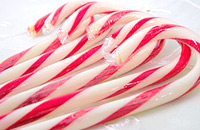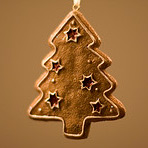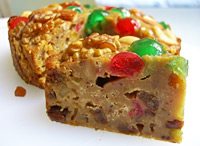December 11, 2009
FOR IMMEDIATE RELEASE
Copper is the Material of Choice for Cooking, According to the Copper Development Association
NEW YORK, NY— It's not too early to think about cooking for the holidays. Whether you're a professional chef or dust off your cookbooks once a year, consider copper in your kitchen. It's the perfect complement to the creation of a traditional holiday meal, according to theCopper Development Association.Why copper? It's a material older than most holiday traditions. Its use as a vessel dates back to 4000 BC. Today, copper pots and pans are durable, beautiful and one of the best conductors for cooking. Heat in a copper pan is conducted evenly, allowing cooks to prepare a dish with less time and energy, regardless of stove top type. Food browns easily without sticking or burning.

Photo by labyrinthx (CC BY-SA 2.0)
The first historical reference in America to the candy cane dates back to 1847. A German immigrant from Wooster, Ohio decorated his Christmas tree with candy canes. The red and white striped candy canes were first made around 1900. Source: CandyCaneFacts.com
Copper bowls work well for whipping up cream and egg whites and for candies that consist of sugary, non-acidic ingredients. Chocolate, caramels, jams and jellies that need to be cooked at precisely controlled temperatures traditionally are made in copper kettles.
Copper is durable and easy to maintain. It's also easy to clean and scratches are simply eliminated. Food doesn't stick to copper pots and pans either. Read more on the advantages of using copper cookware.
Traditionally, copper cookware has played a part in making holiday meals memorable and passed down from generation to generation. Try one of these holiday recipes.
Traditional Holiday Recipes
- During the 18th century in England, it was customary to serve Christmas pudding with punch sauce as a first course. Some puddings were so large, they were boiled in the same huge copper pot used to heat water for a weekly wash. It was considered lucky for family members to "stir up" the pudding mixture before cooking began.
- Still in Victorian England, here's a recipe for a traditional Yorkshire Christmas pie, made of turkey, goose, pheasants or partridges baked with bacon fat and French truffles. The pie is placed in a copper mold.
-
Why are some candies associated with Christmas? Hundreds of years ago, sugar was very expensive and a food for the wealthy. It was often a special treat saved for the holidays and other special occasions. A popular story about the candy cane is that a German choirmaster handed the candy to his young singers in 1670 to keep them quiet during a long church service. When cooking candy with a copper pot, add the candy ingredients as soon as you turn on the heat. Copper pots do not need to pre-heat before use because they conduct heat so evenly and quickly. Cook candy over low heat because it cooks more quickly in a copper pot.

Photo by blogwiese (CC BY-NC-SA 2.0)
German lebkuchen, a gingerbread cookie, has been a traditional holiday food. - Cakes and cookies have been part of festive holiday rituals since ancient times. Many of these recipes and ingredients (cinnamon, ginger, black pepper, almonds, dried fruits, etc.) were introduced to Europe in the Middle Ages. Today's Christmas cookies trace their roots back to these Medieval recipes. Dutch and German settlers, introduced cookie cutters, decorative molds and festive holiday decorations to America. German lebkuchen (gingerbread) probably was the first dessert traditionally associated with Christmas. Copper cookie cutters have been extremely popular in the U.S. Aunt Holly Copper Cookie Cutters offers custom cutters from their shop on the northeast coast of Maine.
-
Fruitcakes, the holiday dessert everyone loves to hate, dates back to the Middle Ages. The cakes have a reputation of lasting a long time. According to historians, Egyptians considered fruitcakes essential food for the afterlife. Crusaders packed fruitcakes as food to tide them over in their long campaigns. No one knows why the fruitcake became part of the holidays. Most likely, it dates back to the English, who passed out slices of cake to poor women singing Christmas carols in the 1700s. Making a rich fruitcake in the 18th century was a lot of work. Fruit was washed and dried, butter was washed in water and rinsed in rosewater and eggs were beaten for more than a half hour. And the cook had to cope with the temperamental wood-fired baking ovens of that time. Immigrants from Germany, England, the Caribbean and other parts of the world brought their own styles of fruitcake to America. The essential ingredients in today's modern fruitcake include red and green candied cherries, pineapple, citron, raisins and nuts. More expensive fruitcakes contain brandy, bourbon or rum. Try this recipe for traditional fruitcake and bake it in a copper dish.

Photo by babeinthecitykl (CC BY-NC 2.0)
Here's a slice of traditional fruitcake. As humorist Russell Baker put it in 1983, "Fruitcake is forever."
###
